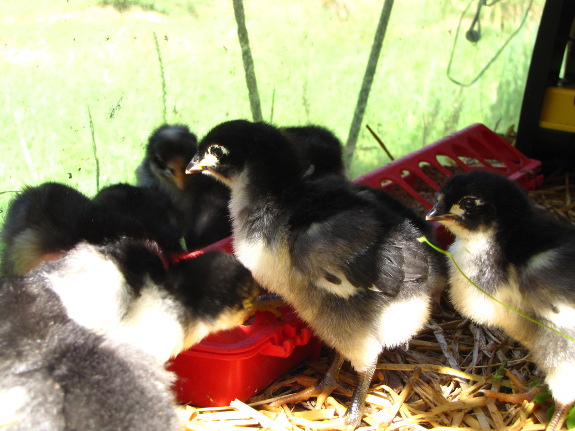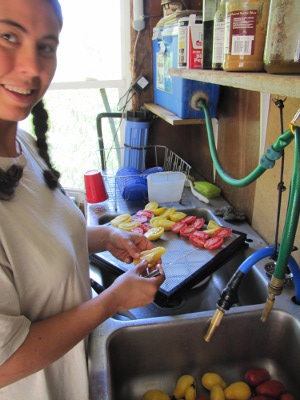
Ready for fall?

I was shocked to wake up
Tuesday morning to chilly weather in the mid 40s. While I'm never
really ready to see summer go, we've reached our freezer goals (20
gallons, mostly soup) and have changed over to drying
tomatoes for winter
treats.
 The fall garden is starting
to produce, and I've been zipping back through with another round of
weeding and mulching before the ground becomes too cold to enjoy
sinking my hands into. Winter weeds have snuck into small spots
of bare ground where I pulled the mulch back to plant seedlings, and I
want to stay ahead of them.
The fall garden is starting
to produce, and I've been zipping back through with another round of
weeding and mulching before the ground becomes too cold to enjoy
sinking my hands into. Winter weeds have snuck into small spots
of bare ground where I pulled the mulch back to plant seedlings, and I
want to stay ahead of them.
Now's also a good time
to kill mulch "lawn" areas that I want to fill with perennials this
winter or vegetables next spring. Mark's done a great job of
reclaiming some brambly patches with persistant mowing this summer, so
a simple kill mulch will be enough to turn those areas into arable
ground.
Despite planning ahead
for fall, winter, and even next spring, I'm far from ready for a
frost. Our average first frost date is October 10, but Bradley
predicts freezing weather to come before the end of September.
What do you think?
Want more in-depth information? Browse through our books.
Or explore more posts by date or by subject.
About us: Anna Hess and Mark Hamilton spent over a decade living self-sufficiently in the mountains of Virginia before moving north to start over from scratch in the foothills of Ohio. They've experimented with permaculture, no-till gardening, trailersteading, home-based microbusinesses and much more, writing about their adventures in both blogs and books.
Want to be notified when new comments are posted on this page? Click on the RSS button after you add a comment to subscribe to the comment feed, or simply check the box beside "email replies to me" while writing your comment.

Yes! Fall is here in our area also.
We are still a month away from any frost if our luck holds. I have a lot of green tomatoes on the vines. So five tomato plants are in planters and will be moved into the greenhouse for futher ripening.
Thank you for the growing tips on winter squash. I will be picking them today for curing.
Mona --- I hope we get another month too --- we should if the weather goes by the book. But when does the weather ever go by the book?
I'm glad to hear my winter squash tips helped out!
Anna, slight change of topic . . . In the last photo I see you are processing your tomatoes for drying and leveraging the corners of a two 'hole' sink to hold the dryer level/pan/shelf - thingy.
When you are doing large pots of soup or other preserving, do you have to rig up additional counter space? Maybe your kitchen has plenty or you have installed permanent solutions? I saw on an apartment living website where someone would bring their ironing board into the kitchen during large assignments; laying towels over the top to manage any potential drips or other things you wouldn't want your subsequent laundry to touch, and then using it for hot pans, rising dough, etc.
Not that many homes are built for 'homesteading' (and preserving) and that picture made me wonder how you have found to work around this issue. Also, have you purchased large, restaurant size pans or containers that aren't in the typical kitchen section of the corner big box discount store?
I buy conventionally raised, run of the mill beef (I was raised by a family of beef producers and the vast majority of the US livestock industry remains smaller family-run pastured cow-calf operations - only the finishing and slaughter ends up dominated by large companies. And I like a bit of grain-fed for my flavor - heritage/culture probably more than anything.) Since I just moved, I've been starting with an empty freezer. I have been running around town trying to find where I could buy affordable (read cheap) wholesale type cryovac cuts of beef (USDA Choice) to cut down myself and package into home size portions of steak, roasts, stew, ground, etc. (The more I try to shop this way with beef, the more I learn about about the meat and how the cut affects the cooking options. Next project - take apart the lawnmower, just to see how it works!) I found an 'open to the public' smallish wholesale type of store; no membership fees, but similarly 'large' helpings of all kinds of things. In addition to the beef, I found lovely restaurant style durable sheet pans of varied sizes, affordable knives, and appropriately sized cutting boards. (I put a flat plastic cutting board inside of a sheet pan and it will catch juices, etc. - super easy to clean up after. Still juggling the counterspace issue though - luckily I only need to do this about once every 3 months . . .)
That recent experience combined with your photo really made me curious how you have adapted the kitchen for your preserving needs. (Oh, also, decades ago both my mother and grandmother had separate canning stoves in different rooms - higher clearance above the stove than the ones they used every day. I just thought of that . . .)
Charity --- I usually don't show my kitchen because it's a tiny mobile home, as you can tell. Mark installed that awesome sink a few years ago, and it's great for preserving. But in terms of counter space, I actually end up doing a lot of cutting on the stove, the tiny table, and a little counter Mark installed. This year, I've enjoyed having the picnic table on the porch since it's much more fun to process out there! Our ten or twenty year wish list includes a "summer kitchen" which will be a screened in porch for cool summer work despite the hot stove, but we're not in a huge hurry.
Mark got me a two gallon, stainless steel pot last year, and it's great. (It was slightly dented, so very marked down at Wal-mart.) We also have a one gallon pot and several half gallon pots, so soup day usually makes four gallons at a time. (Well, really, more like two or three since you can't fill anything up to the brim and it cooks down.) We may get another two gallon pot at some point, but our stove only has one big eye (and three smaller ones), so I'm not sure it'd be as handy as I think. The big upgrade was when we got a stove with all four eyes working a couple of years ago! As you can tell, our kitchen is subpar, but I don't really mind.
We've been buying our red meat in the form of whole lambs from a friend who raises them on pasture. It's been a great learning experience since I've been learning to roast shoulders and cook with other unusual cuts. Your project sounds equally fun and education!